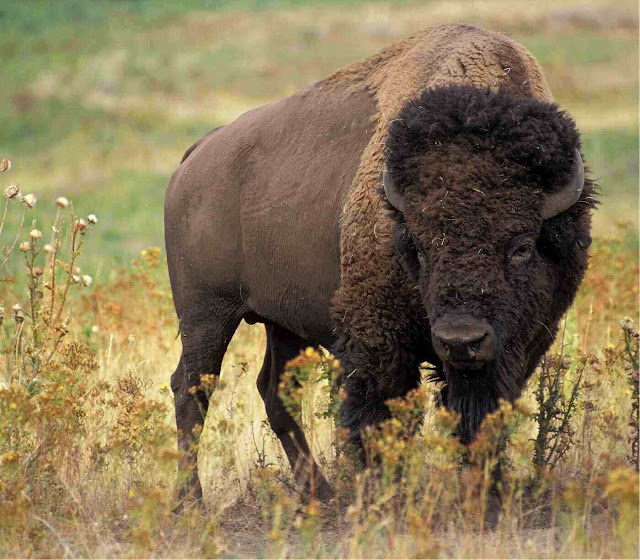
Humans love trying to turn animals into pets. We’re all familiar with kids who make frogs into pets and people who rescue baby raccoons and then try to keep them (at least, that’s the kind of crowd I run with). Needless to say, these adventures usually do not end successfully.
Frogs and raccoons are not, however, the weirdest animals humans have tried (and failed) to domesticate. Not by a long shot. In no particular order, here are some of the strangest.
Quick note: humanity’s zany attempts to domesticate these animals led, as you might expect, to a good deal of animal suffering. This list isn’t meant to minimize that suffering. It might, though, work as a reminder that animals aren’t playthings and that if you got an animal from the wild, that’s where that animal is going to thrive. No matter how much you love them.
Bison
Every so often, someone will make a bison into a house pet. Like Jim Sautner of Spruce Grove, Alberta, whose 1,800 pound bison apparently travels around with him, much like a family dog. Except for the modifications he’s had to make to his car.
While it’s an arrangement that seems to work for him, Gerald Hauer of the Bison Centre says bison “tend to make poor pets.” He explains the two-fold issue that bison usually don’t trust people and quickly fall back on “their ‘flight or fight’ response in order to save their skin.” He also notes that they aren’t solitary creatures, and will go to great lengths to find a herd if one isn’t provided.
We’ll note that they are extremely large, strong creatures and therefore do not even have to be trying to hurt you to hurt you. Pet bison owners Ronnie and Sherron Bridges admitted to Todd Venezia of the New York Post that their pet “has almost accidentally killed them because of his sheer bulk.” Enormous size plus flightiness plus wild instincts does not equal a happy house pet.
Squirrels
In the medieval and early modern periods, squirrels were very common pets. The wealthy would keep them in collars and chains and give them special hutches to live in. The trend followed the British over the ocean to what would become America, where squirrels remained popular into the very early 20th century.
Popular, however, is not the same as tame. People tended to get their squirrels directly from the wild instead of breeding them for specific traits, since squirrels from the forest cost an owner nothing to acquire. Then, as now, squirrels are terribly messy animals, in addition to being a bit hit and miss in the friendship department, so they gradually fell out of favour.
Scottish Wild Cat
This adorable cat is perilously close to extinction—only about 100 are left in the wild, although they were once common all over Britain. While they look much like our own domestic feline friends, they’re infamous for being untameable. Although many have tried.
Joe Gibbs recounts several stories of folks being attacked viciously by the cats, saying “the wildcat keepers at the RZSS’s Highland Wildlife Park near Aviemore have endless tales of wildcats who’ve bitten, scratched and spat at the hands that feed them, even when reared from kittens.”
Moose
Internet lore is rife with stories of moose being trained (and even used) as cavalry animals, especially in Sweden, in the 18th century. Veterinarian and moose specialist Bengt Röken busts that myth, explaining that there “is no documentation to be found in the historic literature about moose used by the ancient military.” He does note, however, that there are several 19th-century accounts of moose calves being raised and trained to pull a sled or go under saddle.
In fact, there’s a famous Canadian story of a New Brunswick man who found an abandoned moose calf one winter and brought it home and raised it. John Connell trained the moose to ride and pull a carriage, apparently with great success.
Even more bizarre is Jack Carr, who raised two calves and brought them from Alaska to Washington state so he could take them on the vaudeville circuit. So why didn’t this practice of domesticating moose catch on? Theories range. Moose are huge, difficult to train, sometimes aggressive (especially in the fall), don’t fare well in captivity and succumb readily to disease. Any one of those reasons would do, really.
Zebras
Another bad idea was for European colonists in Africa to try to domesticate zebras in the 19th and early 20th centuries. Horses were difficult to transport from Europe and had no immune resistance to the diseases they encountered in Africa. Colonists assumed, as they assumed about everything on the African continent, that they would be able to “civilize” them (a word that’s code for “make them bend to the will of Europeans and become financially profitable somehow”).
The zebras had other ideas. Zebras are aggressive and have no qualms about attacking humans. They panic when frightened. And they lack endurance (and perhaps, the willingness to try). So while some colonists made serious attempts to domesticate them as a species, it never really caught on.
There were a few notable (and limited) successes. Zoologist Lord Walter Rothschild (1868-1937), for example, imported several zebras to England, where he trained them to pull a carriage. In 1898, he famously drove the carriage to Buckingham Palace to prove that they could be tamed. He wouldn’t, however, ride them.
There are
many more species that humans have tried to domesticate, and many more species
that have said a polite (or not so polite) “no, thank-you” to our attempts to make
them into pets. Some things are best admired from afar, and these animals are
among them. Especially the wild cat, which is a shame because it is extremely cute.
By Anne Elliot
Feature image: Pixabay; Image 1: Airwolfhound
Featured Strange Pets
